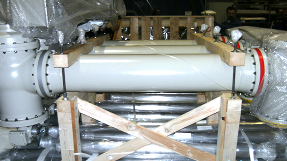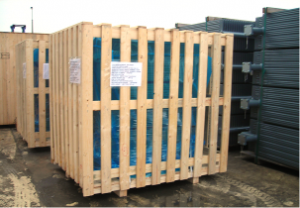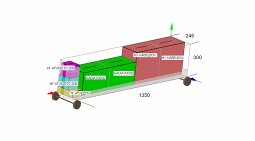The workmanlikely executed seaworthy complies with the long-term transport requirements, that resists the external effects of several handling and manipulation, in- and outdoor loading and unloading, further long-term storage. In this manner the damage- and corrosion-free arrival of the packed product or equipment to the destination can be ensured.
In case of sea transport the shipped products are exposed to extremely aggressive effects due to humid and salt air. In addition these effects can last for a long time, occasionally weeks. In this case the protection of the products is essential, especially in the case of products and equipment tending to corrosion. Sea transport means an intensive physical load at the same time, both during loading and unloading and throughout the whole transport.
We place the products and equipment to be transported within a dry, corrosion-free space, further it is a requirement for the packaging that it has to ensure corrosion protection for a period of minimum one year. In accordance with the customer’s specifications this period can be occasionally longer than a year.
During the preparation of the packaging every surface, that has to be protected against corrosion, is cleaned with solvent and cleaning agent, in order to remove oil, fat, salts, fingerprints, dirt and contaminations. Immediately after cleaning the product or part to be protected is dried, to remove the cleaning solution and every other moisture from the surface. Prior to packing the item to be packed is placed in a low-humidity environment to allow every moisture to evaporate (the drying time depends on the remaining moisture and the ambient humidity).
Every machined, polished or other critical surface is protected against corrosion, dust, moisture, abrasion or any other influence that may adversely affect the appearance of the equipment or component by preserving, packaging, caps, sealing, covering, fixing or other procedure.
Every bolt with external thread is covered with appropriate, non-hydroscopic protective agent, such as plastic cap, impregnated fibreboard or similar protective agent.
We place appropriate amount of material impregnated with anticorrosive agent with VCI-content into every electric box, switchboard, contact breaker panel or similar electric equipment, which works minimum a year (e.g. in case of electric measuring devices, terminals, switches, relays)
Vacuum packing means an effective solution for corrosion protection. During vacuum packing we cover the packed product into an air-tight foil and the air is extracted from the inside of the packaging. The foil is closed finally with heat, previously we put desiccant inside.
In the case of fixing of packed assemblies we take care that the wooden reinforcement cannot perforate the packaging. The packaging shall ensure that the ground or unground metal surfaces do not contact hygroscopic or wet materials, unless their protection is ensured with any other procedure.
The units packed in cardboard or crate are fixed to their place with reinforcement and fixing. We also provide the impact and vibration protection components. Every box is closed safely. We place an appropriately designed pallet under the bundles, which allows the hoisting with fork-lift or pulley.
For vacuum foiling we apply special shrinking foil, for this purpose transparent adhesive foils cannot be used. Upon the construction of the shrink foil we observe that the water cannot collect in the deepening parts of the packaging and cannot corrode the content of the package. It is ensured with the agrar foil fixed inside the top of the crate.
We put desiccant into the packaging. The desiccant cannot contact the packed product, the whole amount shall be distributed uniformly within the package. For the selection of the desiccant we consider the size of the space, the type and character of the material used, the quantity of the moisture around the packaging, the storage period and the atmospheric parameters upon closure of the package. It is essential that the desiccants cannot be used in the same space with corrosion-resistant products of VCI-content. In larger closed areas the bags with the desiccant are suspended, so the moisture is collected far from the packed material.
If required, we use also moisture indicators together with the desiccants. We place the moisture indicator behind an inspection hole, directly behind the closing layer, as far as possible from the desiccant.
The upper limit of the weight of the product in the crate is defined by the crate capacity (standards), the transport method and the lifting procedure. In case of products with significant weight the capacity of the packaging components is verified with static calculations. The large electric engines, generators, transformers can weigh up to several tons, but equipment of 80-90 tons is not uncommon. In this case, the control of the load-bearing capacity of the carrier is mandatory, and in extreme cases the packaged equipment can play the role of the supporting structure (if the product has its own lifting eye) – for example, during lifting of a large generator it is not the packing crate that holds the generator, but the on the contrary, the generator holds the crate, so the packing costs can be kept on an optimum level.
In case the packed equipment requires maintenance, the packaging is provided with hinged doors and/or coverable access openings.
Upon planning of the packaging the unneccessary elevations, feet and crates are eliminated. The elevations increase the transport volume and consequently the transport costs. The transport boxes are designed compact, with the smallest possible volume and spaces are eliminated as much as possible. Anytime it is applicable, the further accessories are placed in the package structre. Upon placement in the inner space the accessories are safely fixed against dislocation.
The timber used for packaging and fixing complies with the requirements of the standard ISPM 15, it is free from bark, living insects and plants, further insect holes. ISPM 15 requires that every timber packaging material shall be heat-treated, regardless of the origin.
Upon preparation of the outside covering we pay special attention to water protection. Every box, crate and case are built in a manner that water cannot ingress and corrode the content, but it can flow out on the bottom, and no stagnant water can develop on the top of the covering.
The packages are finalized in skid or crate execution. On the exterior of the packaging we indicate the point of gravity, the international package handling symbols, we attach the package list and the storage list as well. The storage list contains every information related to external and internal storage in written form.
In case of container delivery we prepare an optimum loading plan that enxures the best use of space of the container(s).
Dry packaging complying with the sea transport requirements
In the physical distribution of goods and products the “packaging” function is the most important link of the logistic chain. Upon design and execution of the packaging it is important that the packaging expert does not primarily use his/her professional skills. The expert shall make all efforts to ensure the balance between the economic value of the product to be packed, its delicacy and the aggressive effects, which the packed product can contact during its shipment to the point of usage.
The workmanlikely executed packaging complies with the long-term transport requirements, it resists the external effects of several handling and manipulation, in- and outdoor loading and unloading, further long-term storage. The package resists the effects of moisture, mould, contaminations, rust and corrosion and ensures that the packed product or equipment arrives at the destination free from damage and corrosion.
In case of sea transport the shipped products are exposed to extremely aggressive effects due to humid and salt air. These influences provide their effects for a long time, occasionally for weeks. In this case the protection of the products is essential, especially in the case of products and equipment tending to corrosion. Sea transport means an intensive physical load at the same time, both during loading and unloading and throughout the whole transport.
Picture 1 The components of the packed equipment are fixed by a reinforcing structure within the package.
We place the products and equipment to be transported within a dry, corrosion-free space, further it is a requirement for the packaging that it has to ensure corrosion protection for a period of minimum one year. In accordance with the customer’s specifications this period can be occasionally longer than a year.
During the preparation of the packaging every surface, that has to be protected against corrosion, is cleaned with solvent and cleaning agent, in order to remove oil, fat, salts, fingerprints, dirt and contaminations. Immediately after cleaning the product or part to be protected is dried, to remove the cleaning solution and every other moisture from the surface. Prior to packing the item to be packed is placed in a low-humidity environment to allow every moisture to evaporate (the drying time depends on the remaining moisture and the ambient humidity).
Every machined, polished or other critical surface is protected against corrosion, dust, moisture, abrasion or any other influence that may adversely affect the appearance of the equipment or component by preserving, packaging, caps, sealing, covering, fixing or other procedure.
Every bolt with external thread is covered with appropriate, non-hygroscopic protective agent, such as plastic cap, impregnated fibreboard or similar protective agent.
We place appropriate amount of material impregnated with anticorrosive agent with VCI-content into every electric box, switchboard, contact breaker panel or similar electric equipment, which works minimum a year (e.g. in case of electric measuring devices, terminals, switches, relays)
Vacuum packing means an effective solution for corrosion protection. During vacuum packing we cover the packed product into an air-tight foil and the air is extracted from the inside of the packaging. The foil is closed finally with heat, previously we put desiccant inside.
Picture 2 For economic use of space we fit the parts to each other.
In the case of fixing of packed assemblies we take care that the wooden reinforcement cannot perforate the packaging. The packaging shall ensure that the ground or unground metal surfaces do not contact hygroscopic or wet materials, unless their protection is ensured with any other procedure.
The units packed in cardboard or crate are fixed to their place with reinforcement and fixing. We also provide the impact and vibration protection components. Every box is closed safely. We place an appropriately designed pallet under the bundles, which allows the hoisting with fork-lift or pulley.
For vacuum foiling we apply special shrinking foil, for this purpose transparent adhesive foils cannot be used. Upon the construction of the shrink foil we observe that the water cannot collect in the deepening parts of the packaging and cannot corrode the content of the package. It is ensured with the agrar foil fixed inside the top of the crate.
We put desiccant into the packaging. The desiccant cannot contact the packed product, the whole amount shall be distributed uniformly within the package. For the selection of the desiccant we consider the size of the space, the type and character of the material used, the quantity of the moisture around the packaging, the storage period and the atmospheric parameters upon closure of the package. It is essential that the desiccants cannot be used in the same space with corrosion-resistant products of VCI-content. In larger closed areas the bags with the desiccant are suspended, so the moisture is collected far from the packed material.
If required, we use also moisture indicators together with the desiccants. We place the moisture indicator behind an inspection hole, directly behind the closing layer, as far as possible from the desiccant.
Picture 3 The content of the package is covered with shrink foil, the air is pumped out from the inside.
The upper limit of the weight of the product in the crate is defined by the crate capacity (standards), the transport method and the lifting procedure.
In case of products with significant weight the capacity of the packaging components is verified with static calculations. The large electric engines, generators, transformers can weigh up to several tons, but equipment of 80-90 tons is not uncommon. In this case, the control of the load-bearing capacity of the carrier is mandatory, and in extreme cases the packaged equipment can play the role of the supporting structure (if the product has its own lifting eye) – for example, during lifting of a large generator it is not the packing crate that holds the generator, but the on the contrary, the generator holds the crate, so the packing costs can be kept on an optimum level.
Picture 4 The packed equipment is covered with sea-resistent foil from outside.
In case the packed equipment requires maintenance, the packaging is provided with hinged doors and/or coverable access openings.
Upon planning of the packaging the unneccessary elevations, feet and crates are eliminated. The elevations increase the transport volume and consequently the transport costs. The transport boxes are designed compact, with the smallest possible volume and spaces are eliminated as much as possible. Anytime it is applicable, the further accessories are placed in the package structre. Upon placement in the inner space the accessories are safely fixed against dislocation.
The timber used for packaging and fixing complies with the requirements of the standard ISPM 15, it is free from bark, living insects and plants, further insect holes. ISPM 15 requires that every timber packaging material shall be heat-treated, regardless of the origin.
Upon preparation of the outside covering we pay special attention to water protection. Every box, crate and case are built in a manner that water cannot ingress and corrode the content, but it can flow out on the bottom, and no stagnant water can develop on the top of the covering.
Picture 5 The packages are placed in a lattice or solid case.
The packages are finalized in skid or crate execution. On the exterior of the packaging we indicate the point of gravity, the international package handling symbols, we attach the package list and the storage list as well. The storage list contains every information related to external and internal storage in written form.
In case of container delivery we prepare an optimum loading plan that enxures the best use of space of the container(s).
Picture 6 Optimal loading plan.


